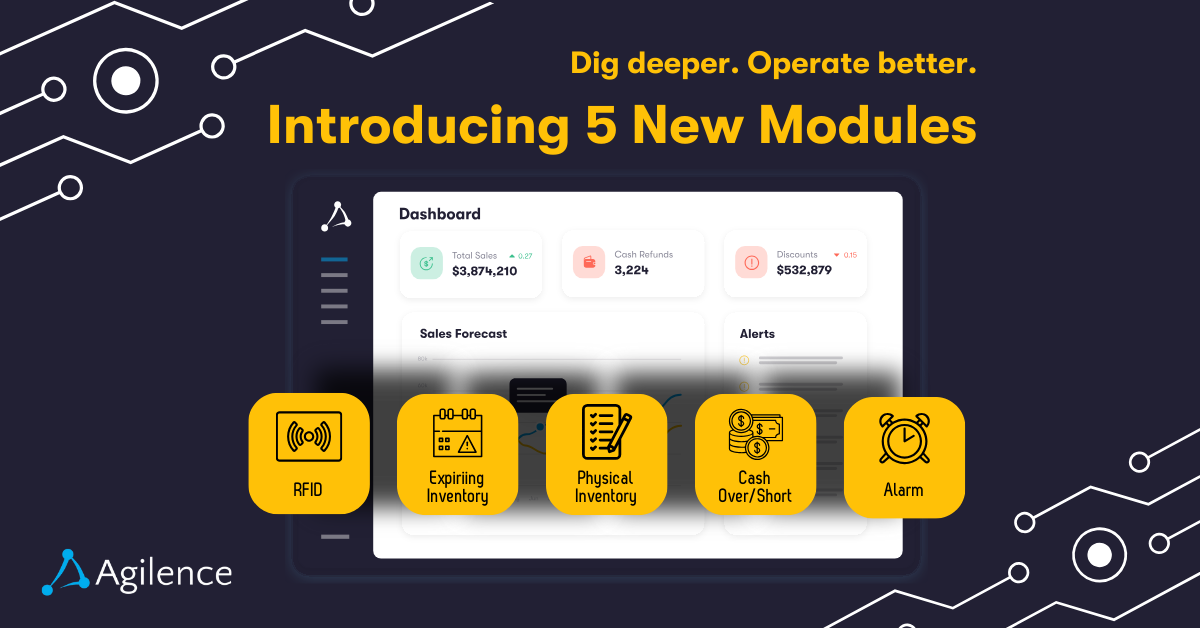7 Retail Trends for 2024
RetailIt’s a new year, which can only mean one thing: a forecast piece! As 2024 begins, retailers are entering an uncertain but ‘guardedly positive’ economic environment, battling rising loss and shrink, trying to address the challenges brought about Organized Retail Crime (ORC), and of course, racing to integrate new technologies and applications such as those enabled by Artificial Intelligence (AI).
In this article, we review 7 retail trends for the year ahead. Many of these trends will be familiar to retailers as a continuation and amplification of trends we saw in 2023, but with more of a focus on action and implementation (especially around AI, ORC, and new loss prevention strategies). Let’s unpack the critical trends that will influence the retail landscape in 2024.
1. Navigating an uncertain retail economic environment
Economic expectations for 2024 are a mixed bag for retailers. Some industry analysts are forecasting growth and celebrating positive consumer sentiment, while others express concerns about the impact of inflation, interest rates, and reduced consumer sentiment.
Citing a recent Commerce Department report, Reuters reports that “strong US retail sales underscore the economy's momentum heading into 2024,” emphasizing how retail sales are exceeding expectations, while Chain Store Age says that consumer spending is expected to continue, remaining robust and consistent. According to data from the Economist Intelligence Unit, a slowdown in inflation could bolster retail volume growth by 6.7% in US dollar terms and 2% in volume terms in 2024. This suggests that if inflationary pressures ease, it could lead to an increase in consumer spending.
However, not all forecasts are optimistic. Forbes reports that average American households could run out of excess liquidity by 2024, potentially impacting consumer spending. The Wall Street Journal predicts a slowdown in expansion to a 1% rate in 2024 due to the moderating labor market and higher interest rates. Meanwhile, McKinsey & Company predicts a modest 2-4% YoY growth for the retail industry in 2024, Forrester sees a ‘tough year’ ahead for retailers, and THE SHOP Magazine anticipates a slower 2.5% retail sales growth compared to the 4.7% growth experienced in 2023.
Amid these varying predictions, the National Retail Federation (NRF) encapsulates the overall sentiment as 'guarded positivity.’ The NRF believes that the robust spending during the 2023 holiday season indicates that consumers remain committed to purchases despite inflationary pressures. However, whether this spirited spending will continue into 2024 remains a question.
No one is quite confident in reading the economic tea leaves right now, but a cautious optimism is probably the best descriptor of the mood. While macroeconomic fear has been elevated, consumer spending has remained robust. But as geopolitical challenges continue to loom and economic headwinds persist due to uneven inflation and elevated interest rates, retailers will need to navigate these uncertainties carefully.
2. AI adoption accelerates throughout the organization
With a lot of hype surrounding the topic, the retail industry is experiencing increased adoption of artificial intelligence, and this will only accelerate in 2024. According to IDC, the retail sector holds the second position globally in terms of AI technology expenditure, highlighting the industry's growing investment in AI technology.
Generative AI, the subset of AI which rekindled renewed interest in AI with the release of Large Language Model (LLMs) tools such as OpenAI’s ChatGPT and image generators such as DALL-E, is set to revolutionize the pre-purchase shopping experience. Generative AI is facilitating the development of advanced chatbots that can handle service inquiries and streamlining content creation across organizations. Retailers are increasingly leveraging AI for deeper personalization in their marketing initiatives, including greater segmentation, personalization, and iterative messaging.
Beyond marketing, AI is finding its application in diverse areas such as inventory management, merchandising, back-office operations, and loss prevention. AI is being deployed in solutions ranging including video analytics, order management, predictive inventory and stock replenishment, smart shopping carts, sales and promotions, financial forecasting and more. Agilence has a series of AI releases scheduled for 2024, including new Case Linking functionality that uses machine learning to automatically uncover correlations between incidents, saving time for loss prevention analysts in pinpointing and combating the root causes of theft and loss.
A study by the IHL Group further reveals that retailers deploying AI and ML technologies have achieved significant success; they reported 2.3 times sales growth and 2.5 times profit growth compared to their competitors in 2023. Projections for 2024 suggest a similar trend for businesses adopting AI/ML solutions. To learn more about AI in retail, check out our AI in Retail blog series and our whitepaper with IHL Group, Retail’s AI Revolution.
3. Embracing social commerce and the creator economy
The rise of social commerce and the creator economy is transforming the retail landscape. According to Statista, global revenue from social commerce is forecasted to surpass 6.2 trillion dollars by 2030. This growth is fueled by the increasing influence of digital content creators who play a pivotal role in shaping consumer behavior.
The creator economy, powered by influencers, vloggers, and even everyday social media users, has democratized the way consumers discover products and services. These creators are seen as trusted community experts, often driving purchases through authentic recommendations based on shared tastes or expertise. Consumers are increasingly relying on their favorite creators for product suggestions, simplifying their shopping experience in a world of endless choices.
This shift towards creator-driven commerce is expected to continue, with Goldman Sachs projecting the creator economy market to double in size to $480 billion by 2027. Retailers recognizing this trend are beginning to treat content creators as integral parts of their brand communities.
Social commerce, facilitated by platforms like Instagram, Facebook, and Pinterest, has become an essential component of a brand's operations. Shoppers now expect to discover and purchase products directly through their social media channels. This evolution of online shopping has been particularly beneficial for private-label brands that utilize these platforms to promote their unique product lines and gather real-time feedback.
Retailers must integrate social commerce strategies into their core business approach to capitalize on this symbiotic relationship. By engaging with content creators that align with their brand values, they can effectively convey their brand story and foster trust among their target demographics.
4. Improved integration of e-commerce and in-store experience
The COVID-19 pandemic served as a catalyst for e-commerce, with lockdowns and social distancing measures pushing consumers towards digital platforms. This shift dramatically altered customer expectations, necessitating a seamless, integrated shopping experience spanning both online and physical stores.
However, despite the meteoric rise of e-commerce, physical retail remains a potent force in the industry. As the National Retail Federation (NRF) reports, “ecommerce levels peaked in April 2020 at almost 19% of retail sales. Since then, levels have dropped to 15%—higher than pre-pandemic but lower than the highest levels in early 2020.”
The future of retail lies not in the death of one channel or the other, but in the seamless integration of both online and offline experiences. In 2024, we can expect to see retailers continue to enhance in-store experiences while simultaneously integrating them with digital channels and e-commerce. The goal here is to provide a truly omnichannel shopping experience, blurring the lines between online and offline retail.
This integration could take many forms. Retailers might use advanced technologies like AI and augmented reality (AR) to create interactive, personalized in-store experiences that mirror the convenience and customization of online shopping. Simultaneously, retailers are leveraging digital tools to bring the in-store experience online. Virtual store tours, live-streamed product demonstrations, and online personal shopping services are just a few examples of how retailers are recreating the tactile and immersive nature of in-store shopping in a virtual environment.
For a better integration of in-store and digital channels, retailers can benefit from the Agilence Analytics eCommerce Module. The eCommerce Module provides powerful insights into e-commerce sales, returns, and customer behaviors. It offers a detailed look into specific e-commerce operations like Buy Online, Pickup In-Store (BOPIS); Buy Online, Return In-Store (BORIS); no-cost sales; and special promotions, as well reconciles inventory for in-store and digital channels and analyzes shipping patterns and identifies areas of concern, improving customer satisfaction, reducing loss, and streamlining operations. Learn more about the eCommerce Module here.
5. Retailers reevaluate self-checkout due to rising losses
Once hailed as the future of retail, self-checkout is now facing significant backlash, with a growing number of retailers reevaluating their use due to increasing losses and customer dissatisfaction. Several leading retailers, including big-box stores like Walmart and Costco, are
scaling back on self-checkout systems. These companies have cited theft, inventory losses, and a lack of fit for their staff and customers as reasons for this change in strategy.
The issue of self-checkout theft is particularly concerning. Shoplifting rates at self-checkout counters have increased, leading to substantial inventory losses. Even everyday customers often abuse the system in small ways with techniques such as ‘the Banana Trick.’ While self-checkout systems were intended to help store operators cut overhead costs, they are often leading to the opposite outcome.
Customer sentiment towards self-checkout systems has also been mixed at best. Many shoppers find these systems frustrating to use, leading to negative shopping experiences. Some large grocery chains such as Wegman’s and the UK’s Booth’s have discontinued self-checkout due to losses and consumer backlash.
Despite the initial promise of self-checkout systems, many retailers are now reconsidering their value. As we move forward, it will be interesting to see how retailers adapt their strategies to balance operational efficiency with customer satisfaction and loss prevention.
6. Rising theft and margin loss is making Loss Prevention a more critical function
In the face of rising theft, loss, and shrink rates, retailers are increasingly recognizing the critical role of loss prevention. In 2023, shrink became a hot topic in the press as major retailers from Target, Kroger, Dick’s Sporting Goods, and more sounded the alarm over increasing inventory theft and Organized Retail crime negatively impacting margins in a serious way.
While this sparked a debate in the media over whether theft raises have actually been rising or not, the numbers are clear that shrink has been growing, whether that’s coming from ORC, internal theft, inventory distortions, or other causes. Major retailers are feeling the financial brunt and putting new urgency on Loss Prevention/Asset Protection and shrink reduction.
To combat these losses, retailers are employing a range of strategies, including increased use of physical methods to prevent theft. This has led to stores locking up items and investing in advanced security systems. However, such measures can cause backlash from shoppers who may perceive them as intrusive or inconvenient.
While physical theft prevention is crucial, it's not the only part of the puzzle. Data and analytics tools, such as Agilence Analytics, are becoming increasingly valuable for loss prevention. They provide insights into patterns of theft and shrink, allowing retailers to pinpoint problem areas and take proactive measures. These tools also help retailers tackle internal theft, a significant contributor to overall shrink.
The current labor shortage also exacerbates theft problems, as fewer staff members on the floor can lead to increased opportunities for both shoplifting and employee theft. Here, too, data can be a powerful tool. By analyzing staffing levels, customer traffic, and theft incidents, retailers can optimize their workforce to reduce theft opportunities.
7. An organized response to Organized Retail Crime (ORC)
Organized Retail Crime (ORC) has long been a thorn in the side of retailers, but retailers, governments, and law enforcement have woken up to the need for a robust and coordinated response. Alongside this, an increasing number of states are passing laws specifically targeting ORC.
Introduced in 2023, the Combating Organized Retail Crime Act is one such effort that's gaining traction at the federal level. Expect this bill to pass with bipartisan support in 2024, marking a significant step forward in the battle against ORC. The bill's provisions include expansion of federal enforcement of criminal offenses related to ORC and an increase in the scope of conduct that qualifies as an offense. The bill also allows prosecutors greater latitude under federal money laundering statutes. This provision will enable them to target those who profit from ORC more effectively, not just those who carry out the thefts.
Perhaps one of the most significant aspects of the bill is the establishment of an ORC Coordination Center within the Department of Homeland Security. This center will coordinate federal law enforcement activities related to ORC, ensuring a more unified and effective response to these crimes.
A growing number of states have also taken legislative action, with 34 states putting ORC laws into place according to the Organized Retail Crime Resource Center. Meanwhile, retail companies are not sitting idle; they're continuing to invest in new technologies and preventative measures to stem ongoing ORC and retail theft losses. Forthcoming AI functionality to link cases in Agilence Case Management will provide retailers with another powerful tool in the fight against ORC.
Related Articles

The Ultimate Guide to RFID in Retail: How Leading Retailers Are Using RFID for Inventory and Loss Prevention
Retail industry leaders across sectors are embracing RFID technology to transform their inventory management and loss prevent...
Agilence Launches Five New Analytics Modules To Address Inventory Loss and Enhance Safety
MOUNT LAUREL, N.J., January 10, 2025 - Agilence, the leader in data analytics and loss prevention solutions for retail, super...
Loss Prevention Stats and Facts Every Retailer Should Know in 2022
With the welcome influx of in-store customers and growing sales volume, retails still need to keep a watchful eye on loss pre...Subscribe to our blog
Receive free educational resources like exclusive reports, webinars, and industry thought leadership articles straight to your inbox.

